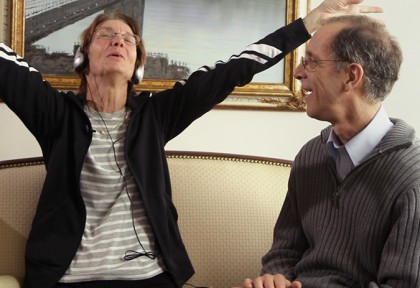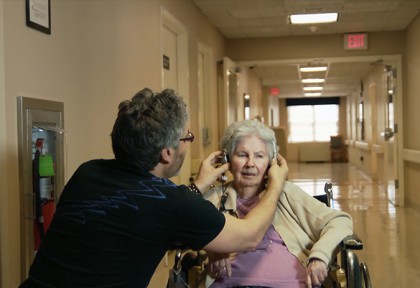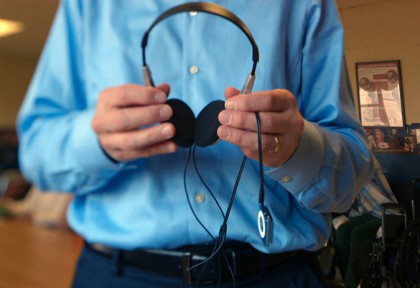Editor’s Note: This story was written by Steven Aquino and first appeared in The Loop Magazine Issue 31, which is available on the App Store for iPhone and iPad.
My maternal grandmother died in 2007, about a month after Steve Jobs introduced the original iPhone at Macworld Expo. Toward the end of her life, she suffered effects from dementia, a disease that robbed her of memories of herself and of her family. That her memory was getting progressively worse hit me hard, as my grandma was a seminal figure of my childhood. She effectively raised me, and it was painful for me to reconcile the person she was to the barely recognizable shell of herself she became. The memories of her with dementia still haunt me to this day, despite all the happy times.
It was my grandmother who immediately came to mind when I was alerted to the film Alive Inside. Alive Inside is a documentary — winner of the Audience Award at the 2014 Sundance Film Festival — which follows Dan Cohen, a medical social worker and executive director of Music & Memory, as he works to introduce music to residents of a New York nursing home. Cohen’s belief is that music is instrumental in helping the elderly with memory loss “rediscover” lost memories, the effects of which help them in being more socially interactive.
All About Accessibility
Cohen introduced patients to the iPod shuffle, loaded with music that the recipient listened to when he or she was younger. The impact was apparent right away: soon after putting on the headphones and hitting Play, patients were bopping their heads to the tunes and even humming along with the songs. These moments were breakthroughs in the truest sense of the word, insofar that music really does have tremendous power in eliciting a slew of emotions and memories in people. Music is meaningful to everyone, but the fact that it works so well for people with brain-related diseases such as dementia or Alzheimer’s means that they no longer have to live withdrawn into themselves all the time. Experiencing music allows patients to be “human” again: singing, moving, being one with the world. It’s powerful stuff, not only for the afflicted, but also for their loved ones.

In the film, Cohen interviews doctors and nurses at the nursing home, who all speak effusively about the influence that music has on residents. And as important as unlocking forgotten memories and facilitating pro-social behavior is, there is another, unique angle to this story: accessibility.
In terms of accessibility, Alive Inside is, at its core, about access. The music — and the iPod itself — gives patients a lifeline to the memories they’ve lost and to the opportunity to open up socially and emotionally through those memories. Furthermore, it is perhaps the quintessential example of just how abstract and far-reaching accessibility truly is. Accessibility is not something that’s limited to just people with physical disabilities or just children in schools. It can also benefit the elderly, as is the case here, and even users with no challenges at all.
The iPod Shuffle: Music Player and Accessibility Tool
The conduit through which this music gets delivered to patients, the iPod shuffle, deserves a look from an accessibility point of view. It was a brilliant choice for two reasons. For one thing, the shuffle has only a few buttons for controlling playback, practically eliminating any learning curve. Patients needn’t worry about which button does what, so there’s less chance of someone becoming frustrated and abandoning the device. Second, the shuffle includes VoiceOver, which is very helpful in announcing artist and song information (not to mention battery status) to listeners. That’s a lifesaver to those who can’t remember what’s currently playing and who’s singing it. In essence, the shuffle is the easiest and simplest iPod of them all.
In a broader sense, the fact that the iPod shuffle is the perfect vehicle for delivering music to the patients featured in Alive Inside underscores an important point: the iPod line has life in it yet. While there can be no denying that the iPod’s relevance (and sales) have steadily faded over the last few years, the truth of the matter is that it still has a place in the market. If nothing else, Cohen shows in the film that the iPod remains a useful device, particularly when we’re talking about the shuffle. The iPod does one thing, and it does it very well; twilight be damned, the iPod is alive and well in fulfilling needs and use cases like it does in Alive Inside.
“Every Nursing Home Should Have iPods Available”
I had the opportunity to talk to Cohen via email about the film and the role the iPod played in his project.

Q: Why help those with Alzheimer’s or dementia?
A: People with dementia — and their families — are in a tough spot. Not only is this a terminal illness, but the progression leads to no longer recognizing family, or even being able to communicate. People become agitated because they are frustrated and then all too often prescribed heavy antipsychotic medications to calm them down. But these drugs come with serious side-effects, and the government is encouraging doctors to stop using these mostly ineffective drugs. Music that holds personal meaning is a back door to one’s cognition and sense of self. Much of the time the drugs can be replaced by music, which is amazing. People become more social and happier. It is not guaranteed to work all the time, but it does mostly. And if it doesn’t work, the worst-case-scenario is no improvement. Forty percent of those with dementia have a more advanced form of the disease. That’s more than 2 million in the U.S. People view them as no longer being able to experience pleasure… and give up on them as a result. With musical favorites, we know we can reach them and change their quality of life for the better.
Q: Why choose the iPod shuffle for this project?
A: Without a screen or click wheel, it is the easiest to use, not just for nursing home residents who are able, but for staff who are managing the iPods for many they care for. Many direct care staff have never owned or used an iPod, so the shuffle makes for great “training wheels.” Once they master the shuffle, they more quickly adopt to other iPod models. Mary Grace Lynch, director of therapeutic recreation at A. Holly Patterson Extended Care Facility in Uniondale, Long Island, New York, has 250 iPods for that many residents. Although she has used all models, the shuffle continues to be her first choice.
Q: What was the response from the residents to the iPod? Was it easy for them to use?
A: The first residents were perfectly capable of using the iPods, as they were in for different physical as opposed to cognitive issues. They had no trouble learning.
Q: How did you choose which music to load onto each iPod? Did you create personalized playlists in iTunes for each person?

A: The key here is total personalization. Long-term care facilities already have no shortage of music from various genres. Just as we wouldn’t want anyone else to pick our favorite songs just because they know what genre we love, the same will be true when we’re older and someone else is doing it for us. We learn as much as we can from each individual if they are able to articulate their preferences. If they are unable, then we work with the family to learn what music they enjoyed when they were young.
Q: Do you see other Apple technologies/products being useful to the elderly? If so, are there any plans to explore them in the future?
A: As soon as the iPad first came out, I loaned mine to nursing homes asking them to “see what you can do with it.” The feedback? It’s better than the music alone. In my view, every nursing home, assisted living facility, and hospital should have iPads available for those they care for. It is part of Music & Memory’s charter to leverage digital technology for this digitally-isolated population.
The iPod Plays On
For anyone interested in music, iPods, or simply who know of family member or friend suffering from Alzheimer’s or dementia, Alive Inside is well worth a watch. (It certainly brought back memories of my grandmother and her battle with dementia.) And Music & Memory gladly accepts donations of old iPods to help with the program. (Speaking of donated iPods, a personal recommendation of mine is to consider creating a personalized playlist for a loved one with Alzheimer’s or dementia; I wish I would have done so for my grandma as she was in the throes of the disease.) The iPod may no longer be the focal point of Apple’s business, long overshadowed by the iPhone and iPad, but even in decline, Apple’s music player still has the ability to make a tremendous impact.
